Study on Catalytic Performance in CO2 Hydrogenation to Methanol over Au–Cu/C3N4 Catalysts
Abstract
:1. Introduction
2. Results and Discussion
2.1. Textural and Structural Properties of the Catalysts
2.2. X-ray Photoelectron Spectroscopy (XPS) Analysis
2.3. Catalyst Reducibility
2.4. Surface Basicity Analysis of the Catalyst
2.5. Evaluation of Catalyst Activity
3. Materials and Methods
3.1. Preparation of Catalysts
3.1.1. Preparation of g-C3N4
3.1.2. Preparation of Au Nanoparticles
3.1.3. Preparation of Au–Cu Nanoparticle Composites
3.1.4. Preparation of Au–Cu/C3N4 Composite Materials
3.2. Characterization of the Catalyst
3.3. Catalyst Activity Evaluation
4. Conclusions
Author Contributions
Funding
Data Availability Statement
Acknowledgments
Conflicts of Interest
References
- Mac Dowell, N.; Fennell, P.S.; Shah, N.; Maitland, G.C. The role of CO2 capture and utilization in mitigating climate change. Nat. Clim. Chang. 2017, 7, 243–249. [Google Scholar] [CrossRef]
- Liu, R.L.; Chen, Z.X.; Yao, Y.; Li, Y.; Cheema, W.A.; Wang, D.W.; Zhu, S.M. Recent advancements in g-C3N4-based photocatalysts for photocatalytic CO2reduction: A mini review. Rsc Adv. 2020, 10, 29408–29418. [Google Scholar] [CrossRef]
- Jones, C.W.; Park, A.H.A.; Wright, P. The Complex Interplay of Separations, Reactions and Storage in Pursuit of Carbon Neutrality: A Central Role for Nanomaterials. Acc. Chem. Res. 2023, 56, 3545–3546. [Google Scholar] [CrossRef]
- Navarro-Jaén, S.; Virginie, M.; Bonin, J.; Robert, M.; Wojcieszak, R.; Khodakov, A.Y. Highlights and challenges in the selective reduction of carbon dioxide to methanol. Nat. Rev. Chem. 2021, 5, 564–579. [Google Scholar] [CrossRef]
- Nisar, A.; Khan, S.; Hameed, M.; Nisar, A.; Ahmad, H.; Mehmood, S.A. Bio-conversion of CO2 into biofuels and other value-added chemicals via metabolic engineering. Microbiol. Res. 2021, 251, 126813. [Google Scholar] [CrossRef]
- Idso, S.B. The search for global Co2 etc greenhouse effects. Environ. Conserv. 1985, 12, 29–35. [Google Scholar] [CrossRef]
- Garba, M.D.; Usman, M.; Khan, S.; Shehzad, F.; Galadima, A.; Ehsan, M.F.; Ghanem, A.S.; Humayun, M. CO2 towards fuels: A review of catalytic conversion of carbon dioxide to hydrocarbons. J. Environ. Chem. Eng. 2021, 9, 104756. [Google Scholar] [CrossRef]
- López, L.R.; Dessì, P.; Cabrera-Codony, A.; Rocha-Melogno, L.; Kraakman, B.; Naddeo, V.; Balaguer, M.D.; Puig, S. CO2 in indoor environments: From environmental and health risk to potential renewable carbon source. Sci. Total Environ. 2023, 856, 159088. [Google Scholar] [CrossRef]
- Hu, C.C.; Lin, C.W.; Hu, C.P.; Keshebo, D.L.; Huang, S.H.; Hung, W.S.; Lee, K.R.; Lai, J.Y. Carbon dioxide enrichment of PDMS/PSf composite membranes for solving the effect and food crisis. J. CO2 Util. 2022, 61, 102011. [Google Scholar] [CrossRef]
- Popovic, S.; Smiljanic, M.; Jovanovic, P.; Vavra, J.; Buonsanti, R.; Hodnik, N. Stability and Degradation Mechanisms of Copper-Based Catalysts for Electrochemical CO2 Reduction. Angew. Chem. Int. Edit. 2020, 59, 14736–14746. [Google Scholar] [CrossRef]
- Cao, S.W.; Li, Y.; Zhu, B.C.; Jaroniec, M.; Yu, J.G. Facet effect of Pd cocatalyst on photocatalytic CO2 reduction over g-C3N4. J. Catal. 2017, 349, 208–217. [Google Scholar] [CrossRef]
- Malati, M.A. Mitigation of CO2 greenhouse effect, combined disposal and utilisation by photocatalysis. Energy Convers. Manag. 1996, 37, 1345–1350. [Google Scholar] [CrossRef]
- Anwer, A.H.; Khan, N.; Khan, M.D.; Shakeel, S.; Khan, M.Z. Redox mediators as cathode catalyst to boost the microbial electro-synthesis of biofuel product from carbon dioxide. Fuel 2021, 302, 121124. [Google Scholar] [CrossRef]
- Zachariah, E.J.; Sabulal, B.; Nair, D.N.K.; Johnson, A.J.; Kumar, C.S.P. Carbon dioxide emission from bamboo culms. Plant Biol. 2016, 18, 400–405. [Google Scholar] [CrossRef]
- Zhang, S.P.; Liu, Z.R. Advances in the biological fixation of carbon dioxide by microalgae. J. Chem. Technol. Biotechnol. 2021, 96, 1475–1495. [Google Scholar] [CrossRef]
- Ran, J.R.; Jaroniec, M.; Qiao, S.Z. Cocatalysts in Semiconductor-based Photocatalytic CO2 Reduction: Achievements, Challenges, and Opportunities. Adv. Mater. 2018, 30, 1704649. [Google Scholar] [CrossRef]
- Xiang, Q.J.; Cheng, B.; Yu, J.G. Graphene-Based Photocatalysts for Solar-Fuel Generation. Angew. Chem. Int. Edit. 2015, 54, 11350–11366. [Google Scholar] [CrossRef]
- Qin, D.Y.; Zhou, Y.; Wang, W.J.; Zhang, C.; Zeng, G.M.; Huang, D.L.; Wang, L.L.; Wang, H.; Yang, Y.; Lei, L.; et al. Recent advances in two-dimensional nanomaterials for photocatalytic reduction of CO2: Insights into performance, theories and perspective. J. Mater. Chem. A 2020, 8, 19156–19195. [Google Scholar] [CrossRef]
- Chen, X.; Jin, F.M. Photocatalytic reduction of carbon dioxide by titanium oxide-based semiconductors to produce fuels. Front. Energy 2019, 13, 207–220. [Google Scholar] [CrossRef]
- Ismael, M. A review on graphitic carbon nitride (g-C3N4) based nanocomposites: Synthesis, categories, and their application in photocatalysis. J. Alloy. Compd. 2020, 846, 156446. [Google Scholar] [CrossRef]
- Schwalbe, M.; Huang, H.; Li, G. Photocatalytic and Photoelectrochemical Carbon Dioxide Reduction. ChemPhotoChem 2022, 6, e202100217. [Google Scholar] [CrossRef]
- Cui, Y.J. In-situ synthesis of C3N4/CdS composites with enhanced photocatalytic properties. Chin. J. Catal. 2015, 36, 372–379. [Google Scholar] [CrossRef]
- Li, J.; Wu, D.D.; Iocozzia, J.; Du, H.W.; Liu, X.Q.; Yuan, Y.P.; Zhou, W.; Li, Z.; Xue, Z.M.; Lin, Z.Q. Achieving Efficient Incorporation of π-Electrons into Graphitic Carbon Nitride for Markedly Improved Hydrogen Generation. Angew. Chem. Int. Edit. 2019, 58, 1985–1989. [Google Scholar] [CrossRef] [PubMed]
- He, Z.Q.; Wang, D.F.; Tang, J.T.; Song, S.; Chen, J.M.; Tao, X.Y. A quasi-hexagonal prism-shaped carbon nitride for photoreduction of carbon dioxide under visible light. Environ. Sci. Pollut. Res. 2017, 24, 8219–8229. [Google Scholar] [CrossRef]
- Shen, M.; Zhang, L.X.; Shi, J.L. Converting CO2 into fuels by graphitic carbon nitride-based photocatalysts. Nanotechnology 2018, 29, 412001. [Google Scholar] [CrossRef]
- Cometto, C.; Ugolotti, A.; Grazietti, E.; Moretto, A.; Bottaro, G.; Armelao, L.; Di Valentin, C.; Calvillo, L.; Granozzi, G. Copper single-atoms embedded in 2D graphitic carbon nitride for the CO2 reduction. NPJ 2D Mater. Appl. 2021, 5, 63. [Google Scholar] [CrossRef]
- Wang, J.B.; Wang, Y.N.; Yu, M.Y.; Li, G.J.; Zhang, S.L.; Zhong, Q. Formation of flaky carbon nitride and beta-Indium sulfide heterojunction with efficient separation of charge carriers for enhanced photocatalytic carbon dioxide reduction. J. Colloid Interface Sci. 2022, 611, 71–81. [Google Scholar] [CrossRef]
- Chagoya, K.L.; Nash, D.J.; Jiang, T.; Le, D.; Alayoglu, S.; Idrees, K.B.; Zhang, X.; Farha, O.K.; Harper, J.K.; Rahman, T.S.; et al. Mechanically Enhanced Catalytic Reduction of Carbon Dioxide over Defect Hexagonal Boron Nitride. ACS Sustain. Chem. Eng. 2021, 9, 2447–2455. [Google Scholar] [CrossRef]
- Kumar, A.; Prajapati, P.K.; Aathira, M.S.; Bansiwal, A.; Boukherroub, R.; Jain, S.L. Highly improved photoreduction of carbon dioxide to methanol using cobalt phthalocyanine grafted to graphitic carbon nitride as photocatalyst under visible light irradiation. J. Colloid Interface Sci. 2019, 543, 201–213. [Google Scholar] [CrossRef] [PubMed]
- Park, H.; Lee, J.H.; Kim, E.H.; Kim, K.Y.; Choi, Y.H.; Youn, D.H.; Lee, J.S. A highly active and stable palladium catalyst on a g-C3N4 support for direct formic acid synthesis under neutral conditions. Chem. Commun. 2016, 52, 14302–14305. [Google Scholar] [CrossRef]
- Deng, K.X.; Hu, B.; Lu, Q.Y.; Hong, X.L. Cu/g-C3N4 modified ZnO/Al2O3 catalyst: Methanol yield improvement of CO2 hydrogenation. Catal. Commun. 2017, 100, 81–84. [Google Scholar] [CrossRef]
- Posada-Pérez, S.; Vidal-López, A.; Solá, M.; Poater, A. 2D carbon nitride as a support with single Cu, Ag, and Au atoms for carbon dioxide reduction reaction. Phys. Chem. Chem. Phys. 2023, 25, 8574–8582. [Google Scholar] [CrossRef]
- Cao, S.W.; Low, J.X.; Yu, J.G.; Jaroniec, M. Polymeric Photocatalysts Based on Graphitic Carbon Nitride. Adv. Mater. 2015, 27, 2150–2176. [Google Scholar] [CrossRef]
- Jia, G.R.; Wang, Z.X.; Gong, M.; Wang, Y.; Li, L.H.; Dong, Y.L.; Liu, L.L.; Zhang, L.; Zhao, J.X.; Zheng, W.T.; et al. Ultrathin origami accordion-like structure of vacancy-rich graphitized carbon nitride for enhancing CO2 photoreduction. Carbon Energy 2023, 5, e270. [Google Scholar] [CrossRef]
- Li, C.M.; Yu, S.Y.; Dong, H.J.; Liu, C.B.; Wu, H.J.; Che, H.N.; Chen, G. Z-scheme mesoporous photocatalyst constructed by modification of Sn3O4 nanoclusters on g-C3N4 nanosheets with improved photocatalytic performance and mechanism insight. Appl. Catal. B-Environ. 2018, 238, 284–293. [Google Scholar] [CrossRef]
- Han, Q.; Wang, B.; Zhao, Y.; Hu, C.G.; Qu, L.T. A Graphitic-C3N4 “Seaweed” Architecture for Enhanced Hydrogen Evolution. Angew. Chem. Int. Edit. 2015, 54, 11433–11437. [Google Scholar] [CrossRef]
- Zhang, J.S.; Zhang, M.W.; Yang, C.; Wang, X.C. Nanospherical Carbon Nitride Frameworks with Sharp Edges Accelerating Charge Collection and Separation at a Soft Photocatalytic Interface. Adv. Mater. 2014, 26, 4121–4126. [Google Scholar] [CrossRef] [PubMed]
- Han, Q.; Wang, B.; Gao, J.; Cheng, Z.H.; Zhao, Y.; Zhang, Z.P.; Qu, L.T. Atomically Thin Mesoporous Nanomesh of Graphitic C3N4 for High-Efficiency Photocatalytic Hydrogen Evolution. ACS Nano 2016, 10, 2745–2751. [Google Scholar] [CrossRef]
- Zhang, Z.H.; Leinenweber, K.; Bauer, M.; Garvie, L.A.J.; McMillan, P.F.; Wolf, G.H. High-pressure bulk synthesis of crystalline C6N9H3•HCl:: A novel C3N4 graphitic derivative. J. Am. Chem. Soc. 2001, 123, 7788–7796. [Google Scholar] [CrossRef]
- Li, P.Y.; Liu, L.; An, W.J.; Wang, H.; Guo, H.X.; Liang, Y.H.; Cui, W.Q. Ultrathin porous g-C3N4 nanosheets modified with AuCu alloy nanoparticles and C-C coupling photothermal catalytic reduction of CO2 to ethanol. Appl. Catal. B-Environ. 2020, 266, 118618. [Google Scholar] [CrossRef]
- Kapustin, G.I.; Brueva, T.R.; Klyachko, A.L.; Beran, S.; Wichterlova, B. Determination of the number and acid strength of acid sites in zeolites by ammonia adsorption—Comparison of calorimetry and temperature-programmed desorption of ammonia. Appl. Catal. 1988, 42, 239–246. [Google Scholar] [CrossRef]
- Faisal, M.; Ismail, A.A.; Harraz, F.A.; Al-Sayari, S.A.; El-Toni, A.M.; Al-Assiri, M.S. Synthesis of highly dispersed silver doped g-C3N4 nanocomposites with enhanced visible-light photocatalytic activity. Mater. Des. 2016, 98, 223–230. [Google Scholar] [CrossRef]
- Liu, C.Y.; Huang, H.W.; Cui, W.; Dong, F.; Zhang, Y.H. Band structure engineering and efficient charge transport in oxygen substituted g-C3N4 for superior photocatalytic hydrogen evolution. Appl. Catal. B-Environ. 2018, 230, 115–124. [Google Scholar] [CrossRef]
- Zhang, Q.Z.; Huang, S.Y.; Deng, J.J.; Gangadharan, D.T.; Yang, F.; Xu, Z.H.; Giorgi, G.; Palummo, M.; Chaker, M.; Ma, D.L. Ice-Assisted Synthesis of Black Phosphorus Nanosheets as a Metal-Free Photocatalyst: 2D/2D Heterostructure for Broadband H2 Evolution. Adv. Funct. Mater. 2019, 29, 1902486. [Google Scholar] [CrossRef]
- Hua, S.X.; Qu, D.; An, L.; Jiang, W.S.; Wen, Y.J.; Wang, X.Y.; Sun, Z.C. Highly efficient p-type Cu3P/n-type g-C3N4 photocatalyst through Z-scheme charge transfer route. Appl. Catal. B-Environ. 2019, 240, 253–261. [Google Scholar] [CrossRef]
- Shu, Z.; Wang, Y.; Wang, W.B.; Zhou, J.; Li, T.T.; Liu, X.Q.; Tan, Y.G.; Zhao, Z.L. A green one-pot approach for mesoporous g-C3N4 nanosheets with in situ sodium doping for enhanced photocatalytic hydrogen evolution. Int. J. Hydrog. Energy 2019, 44, 748–756. [Google Scholar] [CrossRef]
- Sun, Z.C.; Zhu, M.S.; Fujitsuka, M.; Wang, A.J.; Shi, C.; Majima, T. Phase Effect of NixPy Hybridized with g-C3N4 for Photocatalytic Hydrogen Generation. Acs Appl. Mater. Interfaces 2017, 9, 30583–30590. [Google Scholar] [CrossRef]
- Li, Y.; Cheng, C.; Yang, Y.P.; Dun, X.J.; Gao, J.M.; Jin, X.J. A novel electrochemical sensor based on CuO/H-C3N4/rGO nanocomposite for efficient electrochemical sensing nitrite. J. Alloys Compd. 2019, 798, 764–772. [Google Scholar] [CrossRef]
- Karthik, P.; Kumar, T.R.N.; Neppolian, B. Redox couple mediated charge carrier separation in g-C3N4/CuO photocatalyst for enhanced photocatalytic H2 production. Int. J. Hydrog. Energy 2020, 45, 7541–7551. [Google Scholar] [CrossRef]
- Rui, N.; Wang, Z.Y.; Sun, K.H.; Ye, J.Y.; Ge, Q.F.; Liu, C.J. CO2 hydrogenation to methanol over Pd/In2O3: Effects of Pd and oxygen vacancy. Appl. Catal. B-Environ. 2017, 218, 488–497. [Google Scholar] [CrossRef]
- Wang, S.; Song, L.X.; Qu, Z.P. Cu/ZnAl2O4 catalysts prepared by ammonia evaporation method: Improving methanol selectivity in CO2 hydrogenation via regulation of metal-support interaction. Chem. Eng. J. 2023, 469, 144008. [Google Scholar] [CrossRef]
- Dong, X.S.; Li, F.; Zhao, N.; Xiao, F.K.; Wang, J.W.; Tan, Y.S. CO2 hydrogenation to methanol over Cu/ZnO/ZrO2 catalysts prepared by precipitation-reduction method. Appl. Catal. B-Environ. 2016, 191, 8–17. [Google Scholar] [CrossRef]
- Hu, Q.; Fan, G.L.; Yang, L.; Li, F. Aluminum-Doped Zirconia-Supported Copper Nanocatalysts: Surface Synergistic Catalytic Effects in the Gas-Phase Hydrogenation of Esters. Chemcatchem 2014, 6, 3501–3510. [Google Scholar] [CrossRef]
- Prinetto, F.; Ghiotti, G.; Durand, R.; Tichit, D. Investigation of acid-base properties of catalysts obtained from layered double hydroxides. J. Phys. Chem. B 2000, 104, 11117–11126. [Google Scholar] [CrossRef]
- León, M.; Díaz, E.; Bennici, S.; Vega, A.; Ordóñez, S.; Auroux, A. Adsorption of CO2 on Hydrotalcite-Derived Mixed Oxides: Sorption Mechanisms and Consequences for Adsorption Irreversibility. Ind. Eng. Chem. Res. 2010, 49, 3663–3671. [Google Scholar] [CrossRef]
- Scotti, N.; Dangate, M.; Gervasini, A.; Evangelisti, C.; Ravasio, N.; Zaccheria, F. Unraveling the Role of Low Coordination Sites in a Cu Metal Nanoparticle: A Step toward the Selective Synthesis of Second Generation Biofuels. ACS Catal. 2014, 4, 2818–2826. [Google Scholar] [CrossRef]
- Arena, F.; Italiano, G.; Barbera, K.; Bordiga, S.; Bonura, G.; Spadaro, L.; Frusteri, F. Solid-state interactions, adsorption sites and functionality of Cu-ZnO/ZrO2 catalysts in the CO2 hydrogenation to CH3OH. Appl. Catal. A-Gen. 2008, 350, 16–23. [Google Scholar] [CrossRef]
- Liu, C.H.; Guo, X.M.; Guo, Q.S.; Mao, D.S.; Yu, J.; Lu, G.Z. Methanol synthesis from CO2 hydrogenation over copper catalysts supported on MgO-modified TiO2. J. Mol. Catal. A-Chem. 2016, 425, 86–93. [Google Scholar] [CrossRef]
- Guo, X.M.; Mao, D.S.; Lu, G.Z.; Wang, S.; Wu, G.S. Glycine-nitrate combustion synthesis of CuO-ZnO-ZrO2 catalysts for methanol synthesis from CO2 hydrogenation. J. Catal. 2010, 271, 178–185. [Google Scholar] [CrossRef]
- Bansode, A.; Tidona, B.; von Rohr, P.R.; Urakawa, A. Impact of K and Ba promoters on CO2 hydrogenation over Cu/Al2O3 catalysts at high pressure. Catal. Sci. Technol. 2013, 3, 767–778. [Google Scholar] [CrossRef]
- Chang, K.; Wang, T.F.; Chen, J.G.G. Hydrogenation of CO2 to methanol over CuCeTiOx catalysts. Appl. Catal. B-Environ. 2017, 206, 704–711. [Google Scholar] [CrossRef]
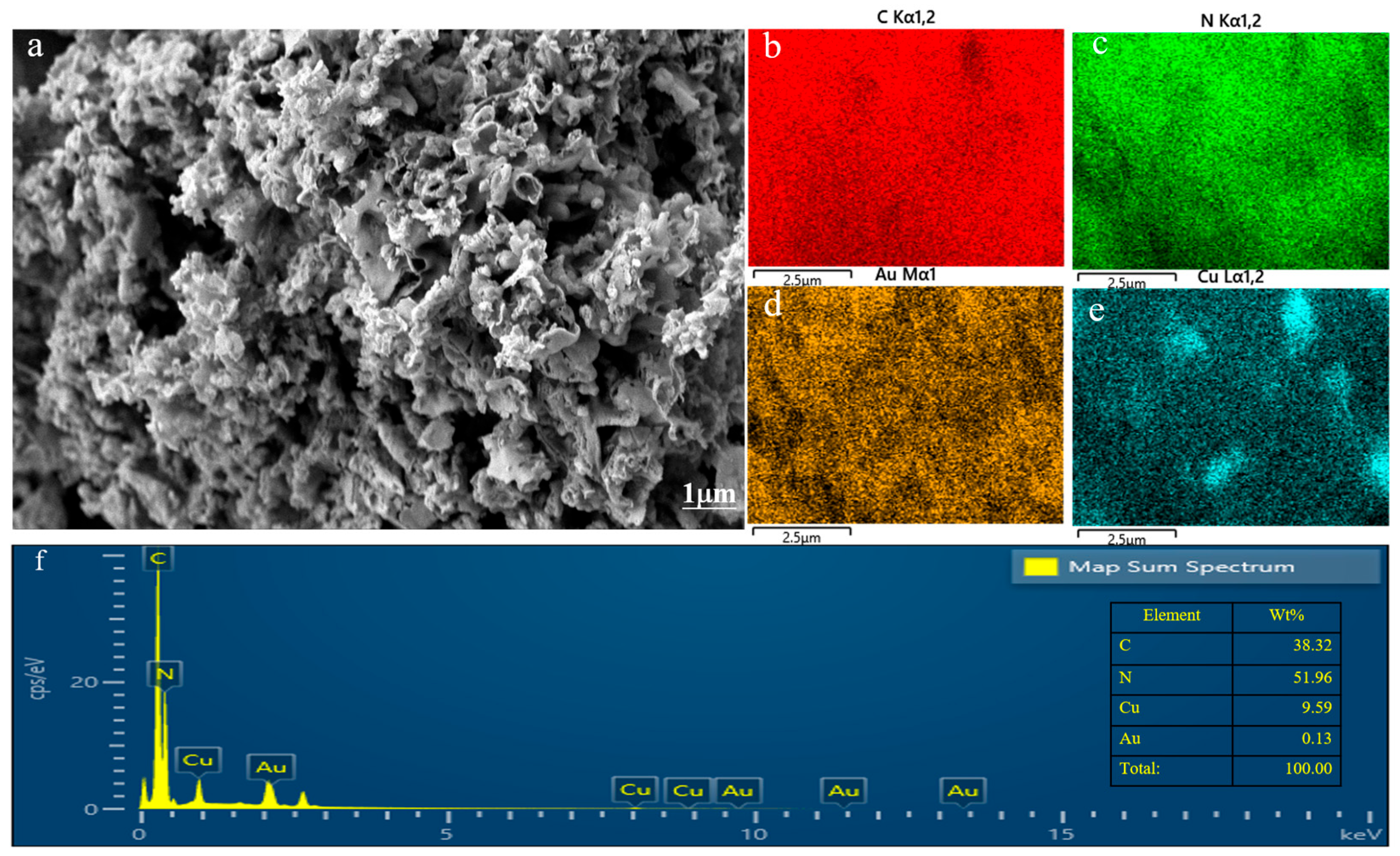

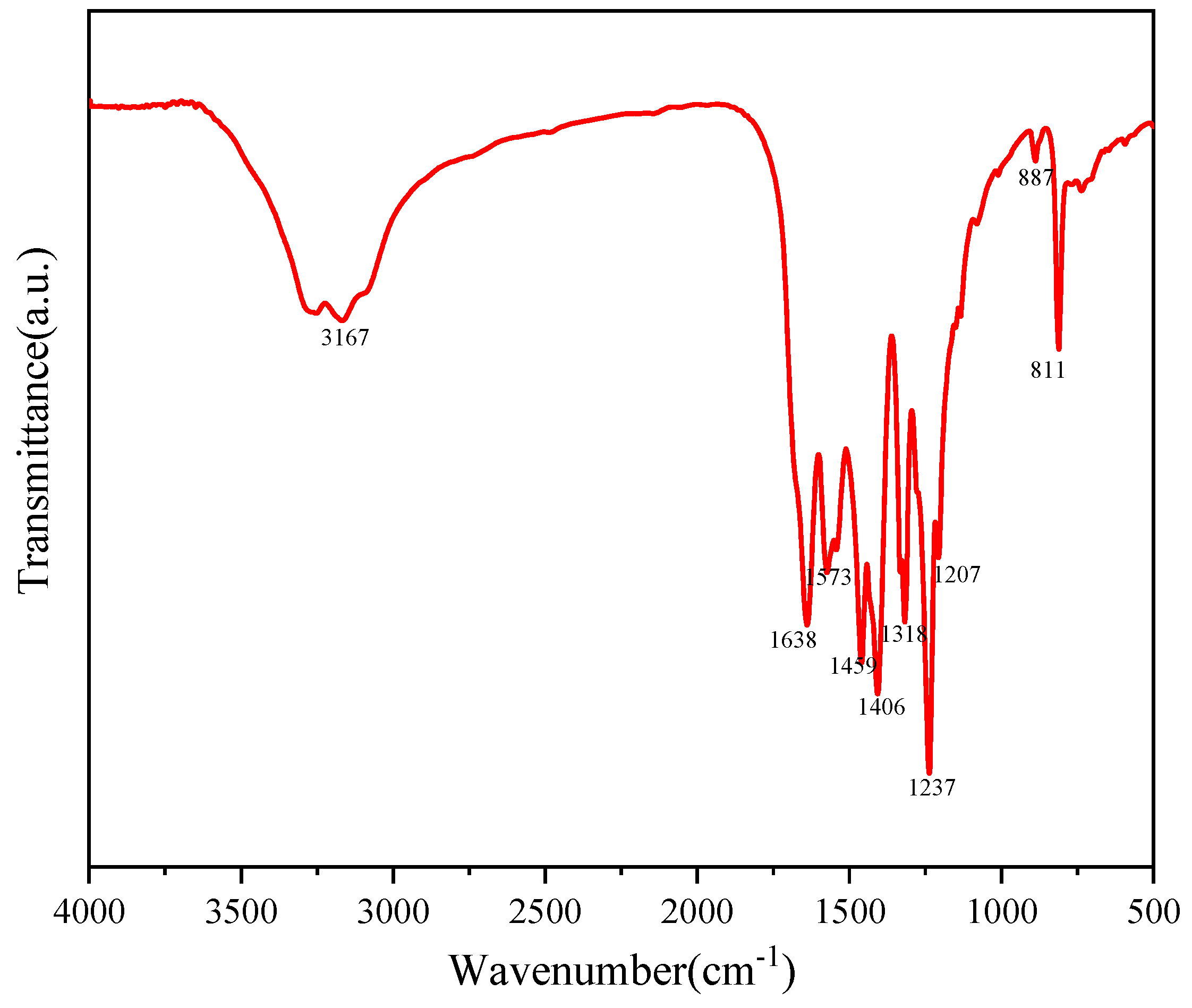
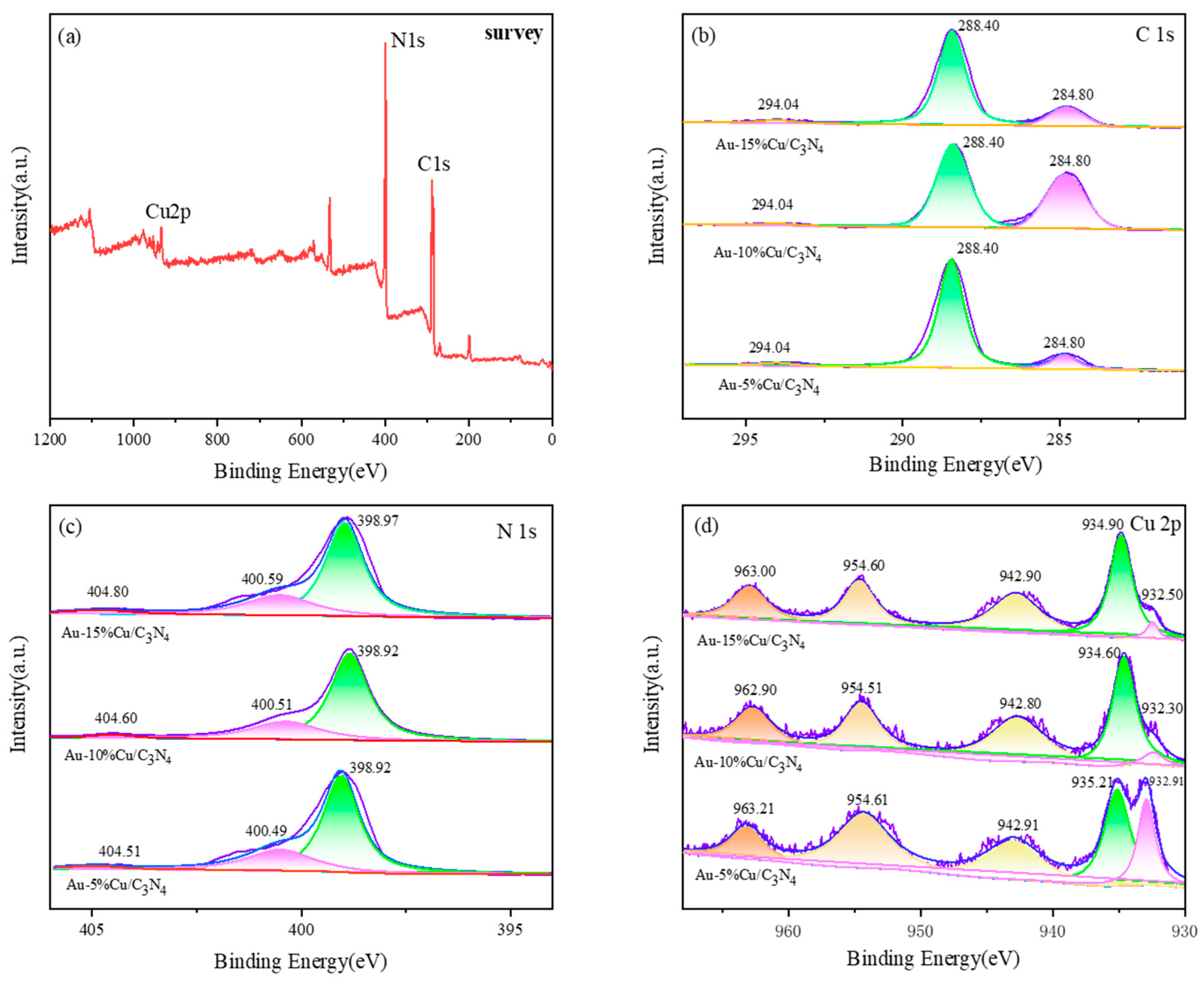
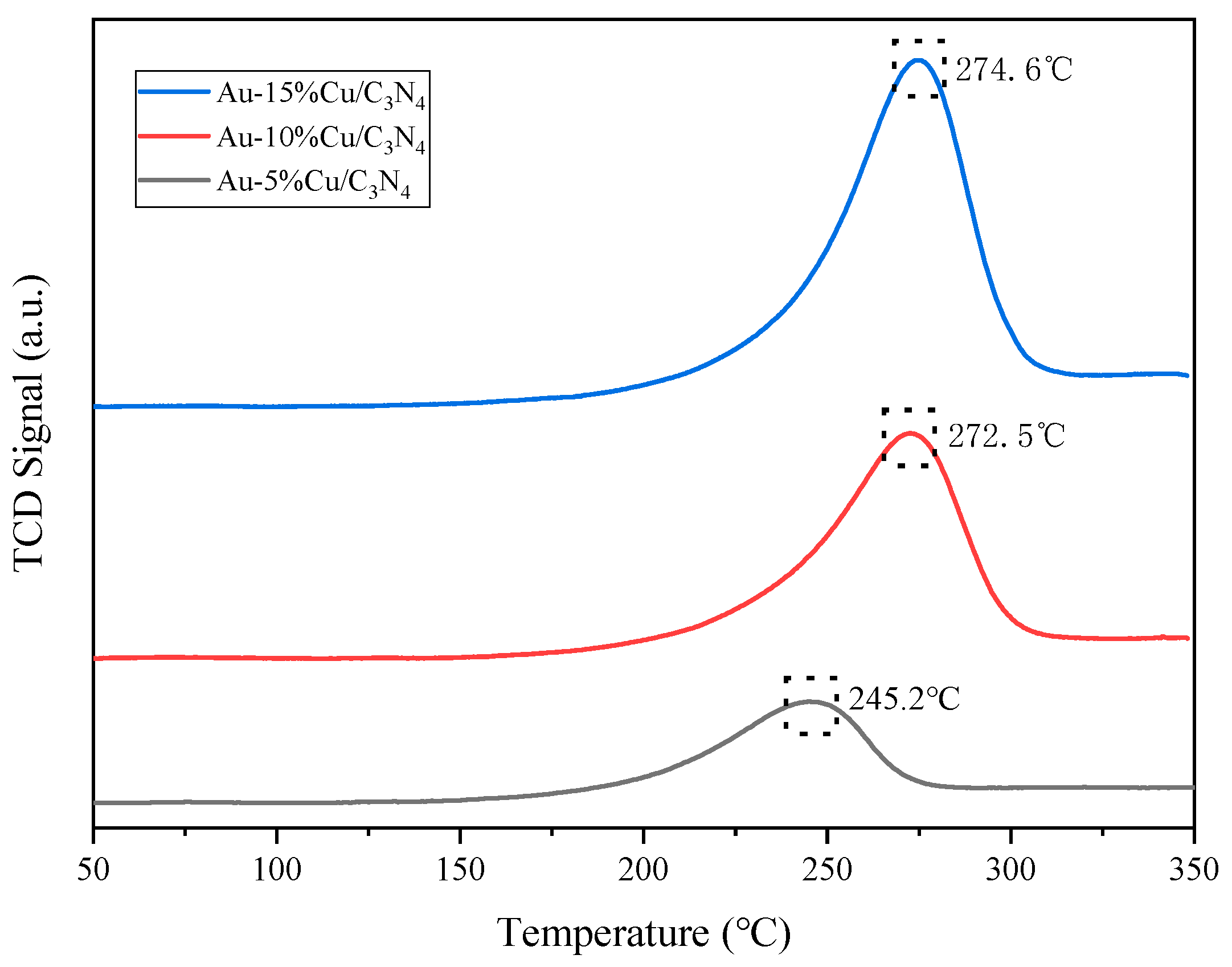
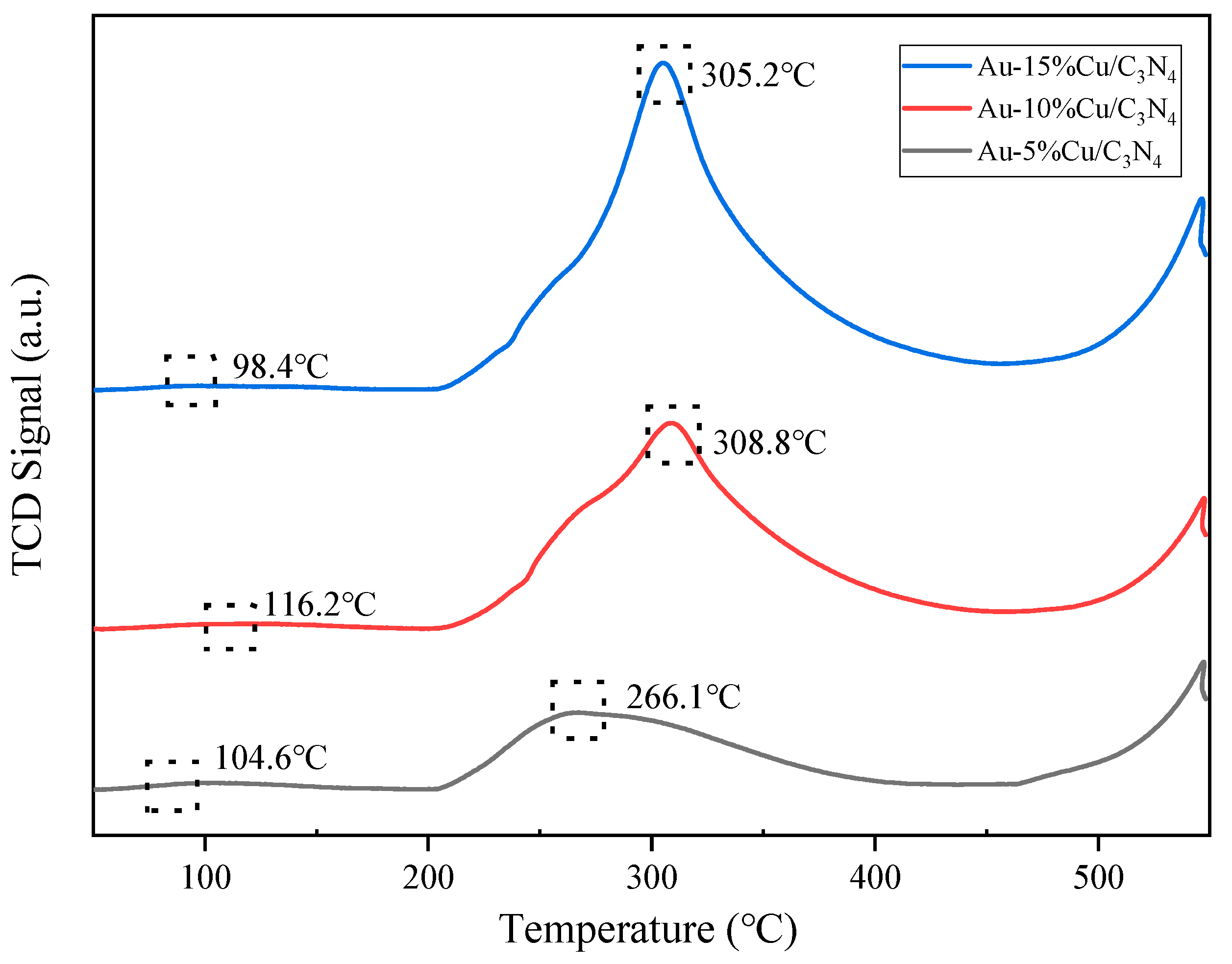
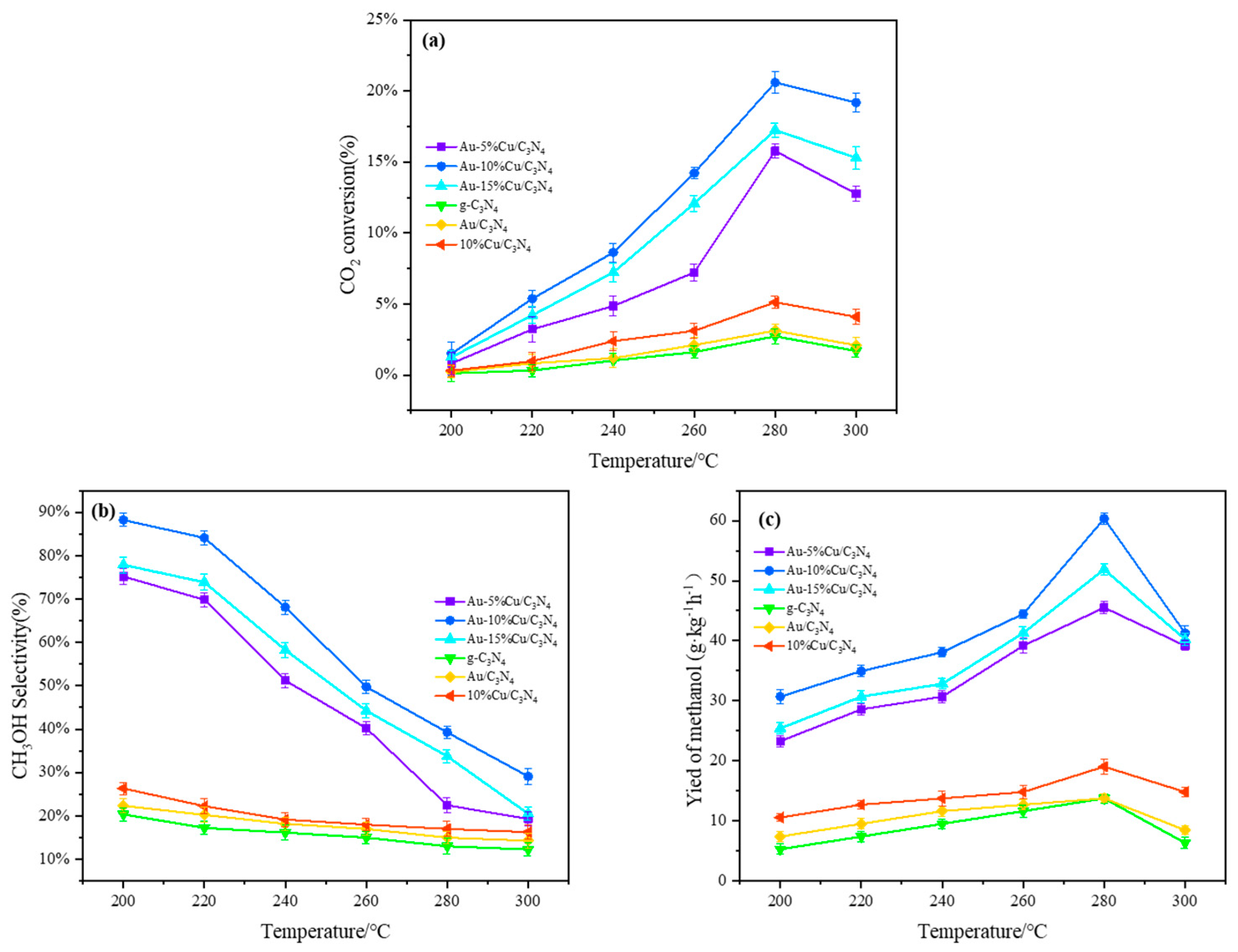
| Samples | SBET (m2g−1) | Pore Volume (cm3g−1) | Average Pore Size (nm) |
|---|---|---|---|
| Au-5%Cu/C3N4 | 60 | 0.31 | 17.55 |
| Au-10%Cu/C3N4 | 76 | 0.41 | 21.01 |
| Au-15%Cu/C3N4 | 71 | 0.32 | 20.99 |
| Catalyst | T/K | P/Mpa | WHSV (mL·g·−1·h−1) | CO2 Conversion Rate | Methanol Yield (g·kg−1·h−1) | Methanol Selectivity | Reference |
|---|---|---|---|---|---|---|---|
| Cu/MgOTiO2 | 493 | 3 | 4800 | 5.2% | 28.58 | 38% | [58] |
| Cu/Al2O3 | 505 | 3 | 4000 | 4.2% | 10.58 | 20% | [60] |
| CuCeTiOx | 508 | 3 | 2000 | 7.8% | 13.76 | 42% | [61] |
| Au-5%Cu/C3N4 | 533 | 3 | 3600 | 7.8% | 34.94 | 46% | Present work |
| Au-10%Cu/C3N4 | 533 | 3 | 3600 | 11.6% | 41.29 | 60% | Present work |
| Au-15%Cu/C3N4 | 533 | 3 | 3600 | 9.6% | 37.05 | 53% | Present work |
Disclaimer/Publisher’s Note: The statements, opinions and data contained in all publications are solely those of the individual author(s) and contributor(s) and not of MDPI and/or the editor(s). MDPI and/or the editor(s) disclaim responsibility for any injury to people or property resulting from any ideas, methods, instructions or products referred to in the content. |
© 2024 by the authors. Licensee MDPI, Basel, Switzerland. This article is an open access article distributed under the terms and conditions of the Creative Commons Attribution (CC BY) license (https://creativecommons.org/licenses/by/4.0/).
Share and Cite
Li, C.; Yang, J.; Zhang, C.; Wang, C.; Lyu, C.; Fan, K. Study on Catalytic Performance in CO2 Hydrogenation to Methanol over Au–Cu/C3N4 Catalysts. Catalysts 2024, 14, 470. https://doi.org/10.3390/catal14080470
Li C, Yang J, Zhang C, Wang C, Lyu C, Fan K. Study on Catalytic Performance in CO2 Hydrogenation to Methanol over Au–Cu/C3N4 Catalysts. Catalysts. 2024; 14(8):470. https://doi.org/10.3390/catal14080470
Chicago/Turabian StyleLi, Chenyang, Jian Yang, Chongbin Zhang, Cong Wang, Chen Lyu, and Kai Fan. 2024. "Study on Catalytic Performance in CO2 Hydrogenation to Methanol over Au–Cu/C3N4 Catalysts" Catalysts 14, no. 8: 470. https://doi.org/10.3390/catal14080470
APA StyleLi, C., Yang, J., Zhang, C., Wang, C., Lyu, C., & Fan, K. (2024). Study on Catalytic Performance in CO2 Hydrogenation to Methanol over Au–Cu/C3N4 Catalysts. Catalysts, 14(8), 470. https://doi.org/10.3390/catal14080470





